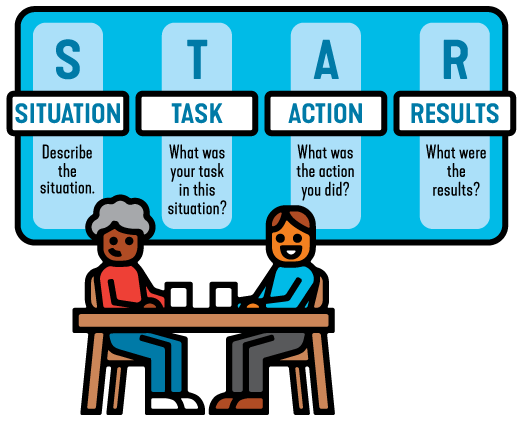Mateus Rocha regularly uses the STAR interview technique throughout the hiring process – together with his team. In this article he explains his approach.
Hiring good people is difficult. Hiring great people is brutally difficult. And yet, nothing matters more in winning than having the right people on the field.
Jack Welch in Winning
When it comes to hiring professionals, we need to be aware of the purpose of the person in the organization, what role they will play, what are the expectations regarding the intended position and what problem this hiring helps to solve for the team and company.
For this reason it is extremely important that hiring is shared not only between HR and managers. Hiring needs to be shared with those who will actually be on the front line with the hired professional, sharing challenges and who have a better context about the work that needs to be developed: Hiring needs to be shared with the TEAM.
I believe that after this statement, some questions are making your head a little dizzy, like:
- “But… when in this vital industry were our employees trained to conduct interviews and hire people?”
- “Is our team mature enough to interview a candidate?”
- “But isn’t hiring just the manager’s responsibility?”
- “And if the team hires wrong, what then?”
In fact, these are very relevant and important questions for the hiring process. After all, research shows that an estimated cost of recruiting and hiring costs an average of 1.5 to 3x the salary of the hired professional. So, you better be very careful. However, on the other hand, not counting on professionals to support this selection and hiring process ends up not making the selection process transparent and with evaluations from different perspectives. That’s why it’s important to work on some professional skills such as: Emotional intelligence, feedback, and conducting interviews using the STAR.
Also read: Virtual Onboarding
The STAR in the famous STAR technique is the acronym for Situation, Task, Action and Result, and it helps managers and teams to conduct more dynamic interviews and not only based on concepts or empty questions, but on practical experiences.
After all, we need real experiences to solve real problems.
Also read: Using Management 3.0 throughout the Employee Experience
What is the STAR method when interviewing? An experience
Years ago, when I was a Change Manager, there was a time when I needed to improve the autonomy of team members, giving them more empowerment to share decisions. Our Agile Coaches needed to be protagonists and often make decisions without my presence. That’s when the idea of including them in the company’s selection process came about, so that they had the opportunity to choose their co-workers and thus analyze which profile best fitted their needs. Not just from the manager’s point of view, but from the team’s point of view.
When I started the process of including team members in the selection process, they were unsure how to behave or what kind of questions to ask, so I made an agreement with them:
- The first two interviews I will conduct and you will observe the questions I ask, how I behave and in the end you will tell me what you think about the candidate.
- In the third and fourth interviews, you will be free to ask the candidate two questions and at the end, we will agree on hiring or not.
- The 5th interview, we will conduct together.
So we started interviewing potential candidates.
In the interview, we always tell the candidate that an interview is nothing more than people deciding whether it makes sense to work together or not and that today’s interviewer can be tomorrow’s interviewee. So, it is important to treat everyone with respect, in addition to encouraging that all responses are based on the STAR model, explained in every interview.

Rephrasing questions to STAR Interview Technique
It was interesting to see each team member evolving in their approaches and questions: One of our team members once asked the following question to a candidate for an agile coach position: “What is the most important value of the agile manifesto for you?”
I confess that I got a bit disappointed, because this question does not “change the price of the euro”, it is not exactly a question using the STAR Interview technique. That is, knowing what the value of the most important agile manifesto is for the candidate does not say about having practical experience or not.
I suggested the team member in a feedback a different approach to this type of question and, in the following interview, I was surprised by the same question posed in a different way:
“Can you tell us about a situation where you used an agile manifesto value to solve a problem?”
I was very happy to see the evolution of this specific team member and all the others!
The result of all this, the result of training the STAR Interview technique, was that they became so independent and expert in interviews that I delegated to them the process of hiring Agile masters who would stay on the teams. I trusted them and they trusted me. I knew they were ready to recruit the best professionals they could to solve the most diverse problems in our organization. I felt fulfilled with their evolution and the responsibility they could now assume.
As a leader, I understand that my main objective is to make people reach their best potential individually and collectively. Empowering them in this process was a wonderful thing.
As you may have noticed, I just used the STAR technique to write this article you just read! I described the situation or context, talked about the task of including them in the hiring process and their difficulties, listed the tasks we performed until they reached the level of autonomy I expected, and shared the wonderful results of being happy and engaged in choosing her companions and companions on the journey!
Did you see?
This is a very common thing, right?
How about starting to include your team in interviews and using the STAR model as a way of working?
Remember:
Management is too important to leave to the managers!

Conducting the interview with the STAR technique
When interviewing a candidate, it comes in handy to have a copy of the behavioral questions close to you, as well as to explain to those involved (interviewer and interviewee) how the interview will take place. Explaining the use of the STAR model to the candidate will help him to perform better in the interview.
The STAR technique in the interview consists of asking purposeful questions and relying on answers based on real experiences and not just on theoretical concepts.
In the 25 behavioral questions proposed in Management 3.0, you will have a good basis for asking really purposeful questions to job candidates.
What are some STAR interview questions?
You can use some purposeful questions like:
“Give an example of a project where the goals were not clear and describe how you handled the situation.”
We’ve all been through situations where the goals weren’t clear, haven’t we? This question helps to understand a little better how each professional sees and acts in this type of situation.
How about this question “Tell me a situation where you were not motivated and how you handled the situation.” We can all feel unmotivated at some point. It is not? How about hearing how the professional acted to regain his motivation? Does it not seem interesting to you?

How To Use the STAR Interview technique to hire great people?
I always use a framework to help guide our process. It is not a perfect recipe, but it can help you and your team to implement a more inclusive and purposeful hiring process:
1 – Define the vacancy and the reason for hiring very well
If you don’t know why you want to hire or what problem the professional needs to solve, you will hardly make an assertive hiring. For this reason, I highly recommend that you start the process by creating a Team Competency Matrix and making it clear which competencies are required for the professional to perform his role well.
2 – Set up a vacancy with very clear descriptions of what is expected of the vacancy candidate.
Focus on the content the candidate needs to know, technologies and tools, processes and practices, and interpersonal skills.
3 – Evaluate the resumes with your team and ask the candidate to fill in the behavioral questions
Evaluating the resumes with the team will help you select the best candidates for the actual interview. Management 3.0 behavioral questions help a lot to understand the candidate’s experiences before asking him to donate part of his time to participate in an interview. What I always talk to professionals about is: If based on the resume and behavioral issues we don’t feel comfortable asking the candidate for an interview, then it’s best not to call them.
4 – At the time of the interview, be cordial.
Remember that if you’ve called a professional for an interview, we want them to be approved! With that in mind, we need to provide conditions for him or her to do well, right? So be cordial, break the ice and make it clear that this is a conversation between professionals deciding if their experiences and expectations make sense for both of them. Don’t forget to give space for the team to ask the questions in the STAR.
5 – Decide with your team whether or not to hire the candidate
The team and manager both need to agree on hiring a professional. Remember that the team usually has more context than the manager and that no one is smarter than collective knowledge with a clear purpose. I recommend talking about the positives and negatives right after the interview. Thus, the verdict is closer. If a professional meets the desired requirements, even if there is something to be improved, hire them soon. Avoid making long and complex selection processes. At the end of the day, they are human beings and need kind and respectful treatment.
Final tip: By doing this, do you guarantee that all hires will be assertive? Of course not. There is no silver bullet for hiring. They are human beings. We can all talk about a selection process. But STAR is not about that. It’s about empowering people to choose their co-workers, develop them to become better and make better decisions. Train your professionals to participate in the selection process and see how much it will help you and your team to make better decisions.
Also read: Collaborative Leadership Explained
How To Use the STAR Interview technique?
As Interviewer
As an interviewer, it is important that you always think that there is a person on the other side of the table, and that the main purpose of an interview is to meet and hire that person. For this reason, it is important to ask structured, purposeful questions and focus on the problem that needs to be solved.
Avoid empty questions such as “what is Management 3.0 (or any other topic)”, “what would you choose between A and B”. Focus on real questions, for example:
- Could you tell us about a situation where you used Management 3.0 practices to solve a problem?
If you need the person to have a lifelong learner profile, don’t ask if the person reads or studies a lot. You can use a more inviting approach to problem solving such as:
- Could you tell us what you do to become a better professional?
- Could you tell us about how something you studied in the last few months helped you solve a problem in your organization?
Always use empathy and keep in mind that you, as the interviewer, need to create an environment for the interviewee to do their best.
How about turning the tables during the interview?
In the interviews we always turn the tables, offering the interviewee the chance to interview us as well. After all, at the end of the day, both candidate and company need to be equally interested, right?
Let the candidate ask you and your team a few questions. This will give them a sense of respect and empathy. We all have questions in a hiring process. It is important that you and your team answer the questions as well.
As Candidate
The interview is a very important moment and it can generate a little anxiety and apprehension, this is very natural for many of us.
This is the main point where STAR can help you. Much more than concepts, STAR can help you remember and structure practical and experienced situations, resulting in attitudes much more than concepts.
Imagine that someone asked you about the main Management 3.0 concepts. It may sound weird to remember all the practices, that Management 3.0 is not a framework but a set of practices and games to help all professionals see the working systems working and also actively participate in the management process.
You could perfectly answer this question using a Situation, Task, Action and Result in which Management 3.0 helped you to solve a real problem in your experience. Much more than concepts without context, a practical application is what makes the difference.

How to master the STAR Method For Interview Questions? Some tips and tricks for both sides:
Interviewer
Be cordial
Focus on experience
Use behavioral questions
Focus on Q&A in the STAR model
Let the candidate ask
Avoid: “What do you know”, concepts only
Candidate
Keep calm
Show what you’ve lived
Study behavioral questions to answer
Focus on answering STAR
Ask the interviewer using STAR
Focus on situations you have experienced and be objective
So, what do you think? Will you experiment using the STAR interview technique in your upcoming hiring process?
Header Photo: LinkedIn Sales Solutions via Unsplash



Great article ! It explored a lot of the situations that I go through while interviewing. The thoughts here are very well organized, easy to understand and practical to apply.